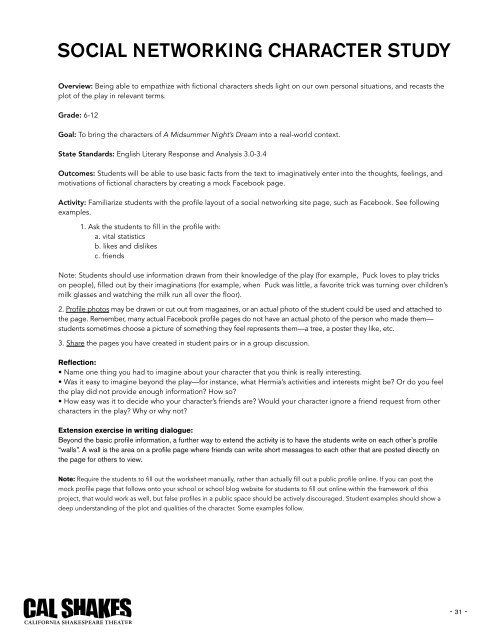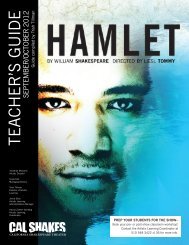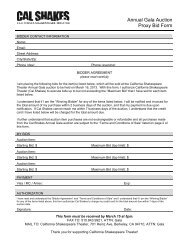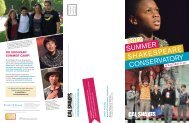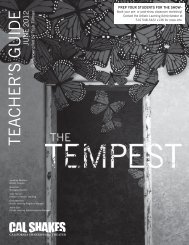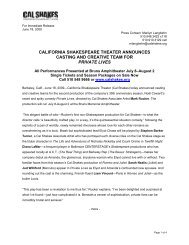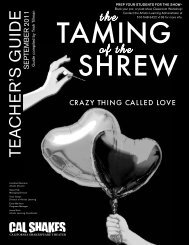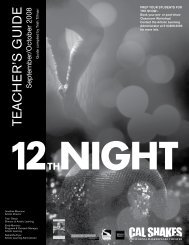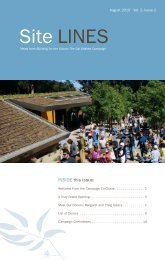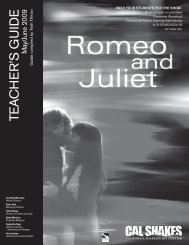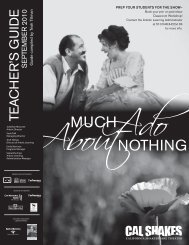A Midsummer Night's Dream - California Shakespeare Theater
A Midsummer Night's Dream - California Shakespeare Theater
A Midsummer Night's Dream - California Shakespeare Theater
You also want an ePaper? Increase the reach of your titles
YUMPU automatically turns print PDFs into web optimized ePapers that Google loves.
SOCIAL NETWORKING CHARACTER STUDY<br />
Overview: Being able to empathize with fictional characters sheds light on our own personal situations, and recasts the<br />
plot of the play in relevant terms.<br />
Grade: 6-12<br />
Goal: To bring the characters of A <strong>Midsummer</strong> Night’s <strong>Dream</strong> into a real-world context.<br />
State Standards: English Literary Response and Analysis 3.0-3.4<br />
Outcomes: Students will be able to use basic facts from the text to imaginatively enter into the thoughts, feelings, and<br />
motivations of fictional characters by creating a mock Facebook page.<br />
Activity: Familiarize students with the profile layout of a social networking site page, such as Facebook. See following<br />
examples.<br />
1. Ask the students to fill in the profile with:<br />
a. vital statistics<br />
b. likes and dislikes<br />
c. friends<br />
Note: Students should use information drawn from their knowledge of the play (for example, Puck loves to play tricks<br />
on people), filled out by their imaginations (for example, when Puck was little, a favorite trick was turning over children’s<br />
milk glasses and watching the milk run all over the floor).<br />
2. Profile photos may be drawn or cut out from magazines, or an actual photo of the student could be used and attached to<br />
the page. Remember, many actual Facebook profile pages do not have an actual photo of the person who made them—<br />
students sometimes choose a picture of something they feel represents them—a tree, a poster they like, etc.<br />
3. Share the pages you have created in student pairs or in a group discussion.<br />
Reflection:<br />
• Name one thing you had to imagine about your character that you think is really interesting.<br />
• Was it easy to imagine beyond the play—for instance, what Hermia’s activities and interests might be? Or do you feel<br />
the play did not provide enough information? How so?<br />
• How easy was it to decide who your character’s friends are? Would your character ignore a friend request from other<br />
characters in the play? Why or why not?<br />
Extension exercise in writing dialogue:<br />
Beyond the basic profile information, a further way to extend the activity is to have the students write on each other’s profile<br />
“walls”. A wall is the area on a profile page where friends can write short messages to each other that are posted directly on<br />
the page for others to view.<br />
Note: Require the students to fill out the worksheet manually, rather than actually fill out a public profile online. If you can post the<br />
mock profile page that follows onto your school or school blog website for students to fill out online within the framework of this<br />
project, that would work as well, but false profiles in a public space should be actively discouraged. Student examples should show a<br />
deep understanding of the plot and qualities of the character. Some examples follow.<br />
- 31 -


